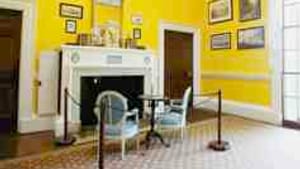Stay in the Loop
BSR publishes on a weekly schedule, with an email newsletter every Wednesday and Thursday morning. There’s no paywall, and subscribing is always free.
Fashion vs. history: Remaking Thomas Jefferson (Part 2)
Ralph Lauren at Monticello (Part 2)

My recent BSR article about Ralph Lauren's makeover of Thomas Jefferson's dining room at Monticello has provoked questions and challenges from readers, such as: Who authorized this project? How much did Lauren contribute, financially or artistically? Were the changes really as bad as I suggested? So I've done further research.
Susan R. Stein, Monticello's vice president and curator, told me she takes full responsibility for what she calls the "reinterpretation" of the dining room. She emphatically denied that Ralph Lauren had anything to do with the project's design, and further indicated that crediting the firm for participating in the project must have been a mistake on the part of Elle Décor magazine's website and slideshow (and whatever other publications may have credited Lauren).
On the other hand, she acknowledged that a number of the furnishings featured at Monticello are in fact new. This means, of course, that the makeover is not a restoration, as the Elle Décor article claimed, since only originals or antiques of the period could qualify for a genuine restoration of Thomas Jefferson's home.
On the subject of Ralph Lauren Home's contribution of table linens covering the entire dining room table to the floor, along with additional gray-and-white linens, carafe, and glasses, Stein justifies these contributions (and the reproduction furniture), since they are "fresh and new and current…and fashionable." When I asked her what motivated her to replace the old with the new, she replied that she wants to provide revolutionary perspectives in order to draw new visitors and additional funding to Monticello. Without Ralph Lauren's substantial grant, she added, the dining room project could not have taken place.
When I called Polo Ralph Lauren, I was referred to Alexandra Ginnel, who is in charge of press relations. She said that Ralph Lauren paid for the entire Monticello project but wasn't involved in the design process, which she says was the work of Charlotte Moss, a Virginia-born interior designer who creates and sells china, and whom Elle Décor credits with the new table settings at Monticello. Ginnel said that Moss "partook to bring relevance to an American historical site that many may not relate to in a modern way. Her use of present consumer products brought the historical aspect of it full circle… She chose modern furnishings to reinterpret the room in a modern way. She chose almost all the furnishings in the room."
I read Ginnel the Charlottesville (va.) Area Daily piece entitled, "Polo Does Monticello," specifically these excerpts: "Consider a visit to… the dining room recently renovated by Ralph Lauren Home. … Working in partnership with the Thomas Jefferson Foundation, Ralph Lauren sponsored the dining room restoration, including a reproduction of a sideboard similar to one Jefferson bought in 1790, a French marble console table, and an interpretation of the Abbeville carpet Jefferson purchased in France in the 1780s." Ginnel admitted that she had sent information about the Monticello project to Area Daily.
Regardless of who actually designed what, this much seems patently clear: One of our nation's most treasured historic sites has been hugely commercialized.
Monticello is not just a beloved monument; it's also a beautiful example of the personal environment of a great man. To repeat my original point: It seems a terrible shame to introduce brand-new features and commercial products to a historic landmark in order to create a little excitement.
Susan R. Stein, Monticello's vice president and curator, told me she takes full responsibility for what she calls the "reinterpretation" of the dining room. She emphatically denied that Ralph Lauren had anything to do with the project's design, and further indicated that crediting the firm for participating in the project must have been a mistake on the part of Elle Décor magazine's website and slideshow (and whatever other publications may have credited Lauren).
On the other hand, she acknowledged that a number of the furnishings featured at Monticello are in fact new. This means, of course, that the makeover is not a restoration, as the Elle Décor article claimed, since only originals or antiques of the period could qualify for a genuine restoration of Thomas Jefferson's home.
On the subject of Ralph Lauren Home's contribution of table linens covering the entire dining room table to the floor, along with additional gray-and-white linens, carafe, and glasses, Stein justifies these contributions (and the reproduction furniture), since they are "fresh and new and current…and fashionable." When I asked her what motivated her to replace the old with the new, she replied that she wants to provide revolutionary perspectives in order to draw new visitors and additional funding to Monticello. Without Ralph Lauren's substantial grant, she added, the dining room project could not have taken place.
When I called Polo Ralph Lauren, I was referred to Alexandra Ginnel, who is in charge of press relations. She said that Ralph Lauren paid for the entire Monticello project but wasn't involved in the design process, which she says was the work of Charlotte Moss, a Virginia-born interior designer who creates and sells china, and whom Elle Décor credits with the new table settings at Monticello. Ginnel said that Moss "partook to bring relevance to an American historical site that many may not relate to in a modern way. Her use of present consumer products brought the historical aspect of it full circle… She chose modern furnishings to reinterpret the room in a modern way. She chose almost all the furnishings in the room."
I read Ginnel the Charlottesville (va.) Area Daily piece entitled, "Polo Does Monticello," specifically these excerpts: "Consider a visit to… the dining room recently renovated by Ralph Lauren Home. … Working in partnership with the Thomas Jefferson Foundation, Ralph Lauren sponsored the dining room restoration, including a reproduction of a sideboard similar to one Jefferson bought in 1790, a French marble console table, and an interpretation of the Abbeville carpet Jefferson purchased in France in the 1780s." Ginnel admitted that she had sent information about the Monticello project to Area Daily.
Regardless of who actually designed what, this much seems patently clear: One of our nation's most treasured historic sites has been hugely commercialized.
Monticello is not just a beloved monument; it's also a beautiful example of the personal environment of a great man. To repeat my original point: It seems a terrible shame to introduce brand-new features and commercial products to a historic landmark in order to create a little excitement.
Sign up for our newsletter
All of the week's new articles, all in one place. Sign up for the free weekly BSR newsletters, and don't miss a conversation.

 Caroline Dunlop Millett
Caroline Dunlop Millett